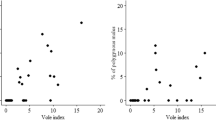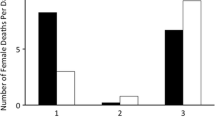Abstract
In polygynous species, the adults are faced with a dilemma during chick rearing. Males must decide how to distribute food between their females and food allocation patterns are often highly unequal. In turn, the females that receive less food from males have to decide how much time to invest in additional hunting. If they spend more time hunting, then they leave their young exposed to weather and predators. However, if they stay at the nest, they increase the risk of their chicks starving. One way that birds may compensate for reduced provisioning is by increasing the size of prey caught. We tested this hypothesis by comparing prey deliveries to nests of hen harriers, Circus cyaneus, with females of different breeding status. As expected, male harriers delivered less food items to the nests of polygynous females, and especially their secondary, or β females. However, both sexes were able to compensate by delivering larger items and there was no difference in the overall mass of food delivered to nests. Moreover, females spent a similar amount of time at the nest, irrespective of status, and there were no overall differences in breeding success. Our results show that polygynous female harriers can compensate for the costs of polygyny, but we suggest that their ability to do so will vary according to the abundance of both large prey and predators.




Similar content being viewed by others
References
Alatalo RV, Carlson A, Lundberg A, Ulfstrand S (1981) The conflict between male polygamy and female monogamy: the case of the pied flycatcher Ficedula hypoleuca. Am Nat 117:738–753
Alatalo RV, Gottlander K, Lundberg A (1988) Conflict or coorperation between parents in feeding nestlings in the pied flycatcher Ficedula hypoleuca. Ornis Scand 19:31–34
Altenburg W, Daan S, Starkensburg J, Ulfstrand S (1982) Polygamy in the marsh harrier, Circus aeruginosus: individual variation in hunting performance and number of mates. Behaviour 79:272–312
Balfour E, Cadbury CJ (1979) Polygyny, spacing and sex ratio among hen harriers Circus cyaneus in Orkney, Scotland. Ornis Scand 10:133–141
Barnard P, MacWhiter B, Simmons R, Hansen GL, Smith PC (1987) Timing of breeding and the seasonal important of passerine prey to breeding northern harriers (Circus cyaneus). Can J Zool 65:1942–1950
Clutton-Brock TH (1991) The evolution of parental care. Princeton Univ. Press, Princeton, NJ
Cramp S, Simmons KEL (1980) The birds of the Western Palearctic, Vol. 2. Oxford University Press, Oxford
Duckworth JW (1992) Effects of male removal on the behavior and reproductive success of reed warblers Acrocephalus sciripaceus. Ibis 134:164–170
Fuller RM, Groom GB, Jones AR (1994) The land cover map of Great Britain: an automated classification of Landsat Thematic Mapper data. Photo Eng Rem Sen 60:553–562
Hamerstrom F, Hamerstrom FN, Burke CJ (1985) Effects of roles and mating systems in a Central Wisconsin population of harriers. Wilson Bulletin 97:332–346
Hartley IR, Shepherd M (1994) Female reproductive success, provisioning of nestlings and polygyny in corn buntings. Anim Behav 48:717–725
Johnson LS, Kermott LH (1993) Why is reduced male parental assistance detrimental to the reproductive success of secondary female house wrens? Anim Behav 46:1111–1120
Littell RC, Milliken GA, Stroup WW, Wolfinger RD (1996) SAS system for mixed models. SAS Institute, Cary, NC
Newton I (1979) Population Ecology of Raptors. T & AD Poyser, Berkhamsted
Orians GH, Whittenberger JF (1991) Spatial and temporal scales in habitat selection. Am Nat 137:S29–S49
Picozzi N (1978) Dispersion, breeding and prey of hen harrier Circus cyaneus in Glen Dye, Kincardineshire. Ibis 120:498–509
Picozzi N (1984) Breeding biology of polygynous hen harriers Circus c. cyaneus in Orkney. Ornis Scand 15:1–10
Redpath SM, Thirgood SJ (1997) Birds of prey and red grouse. Stationery Office, London
Redpath SM, Thirgood SJ (1999) Numerical and functional responses in generalist predators:hen harriers and peregrines on Scottish grouse moors. J Anim Ecol 68:879–892
Redpath SM, Thirgood SJ, Leckie F (2001) Does diversionary feeding reduce predation of red grouse by hen harriers? J Appl Ecol 38:1157–1168
Redpath SM, Thirgood SJ, Clarke RG (2002) Field vole abundance and hen harrier diet and breeding success in Scotland. Ibis 144:E33–E39
SAS Institute (2001) SAS/STAT Users’ Guide, Version 8.01, SAS Institute, Cary, NC
Schipper WJA (1973) A comparison of prey selection in sympatric harriers (Circus) in Western Europe. Le Gerfaut 63:17–120
Sejberg D, Bensch S, Hasselquist D (2000) Nestling provisioning in polygynous great reed warblers (Acrocephalus arundinaceus): do males bring larger prey to compensate for fewer nest visits? Behav Ecol Sociobiol 47:213–219
Simmons RE, Barnard P, MacWhirter B, Hanson GL (1986a) The influence of microtines on polygyny, productivity, age, and provisioning of breeding Northern Harriers:a 5-year study. Can J Zool 64:2447–2456
Simmons RE, Smith PC, MacWhirter RB (1986b) Hierarchies among Northern Harrier (Circus cyaneus) harems and the costs of polygyny. J Anim Ecol 55:755–771
Slagsvold T, Lifjeld JT (1994) Polygyny ion birds: the role of competition between females for male parental care. Am Nat 143:59–94
Webster MS (1991) Male parental care and polygyny in birds. Am Nat 137:274–280
Wheelwright NJ, Schultz CB, Hodum PJ (1992) Polygyny and male parental care in savannah sparrows:effects on female fitness. Behav Ecol Sociobiol 31:279–289
Whittingham LA, Robertson RJ (1994) Food availability, parental care and male mating success in red-winged blackbirds (Agelaius phoenecius). J Anim Ecol 63:139–150
Wolf L, Ketterson ED, Nolan V (1990) Behavioral response of female dark-eyed juncos to the experimental removal of their mates — implications for the evolution of male parental care. Anim Behav 39:125–134
Yasukawa K, McClure JL, Boley RA, Zanocco J (1990) Provisioning of nestlings by male and female red-winged blackbirds, Agelaius phoeniceus. Anim Behav 40:153–166
Acknowledgements
We thank the Buccleuch Estates for their support and for allowing us to work on their estate. Many assistants helped in the field, including G. Buchanen, S. Campbell, C. Cronin, E. Donnelly, C. Hill, P. Lindley, J. Martinez, R. May, D. Parish, A. Smith and A. Tharme. The study was funded by Buccleuch Estates, Westerhall Estates, Game Conservancy Trust and Scottish Research Trust, Institute of Terrestrial Ecology, Joint Nature Conservation Committee, Royal Society for the Protection of Birds and Scottish Natural Heritage. This study complied with current UK laws.
Author information
Authors and Affiliations
Corresponding author
Additional information
Communicated by C. Brown
Rights and permissions
About this article
Cite this article
Redpath, S.M., Leckie, F.M., Arroyo, B. et al. Compensating for the costs of polygyny in hen harriers Circus cyaneus . Behav Ecol Sociobiol 60, 386–391 (2006). https://doi.org/10.1007/s00265-006-0176-2
Received:
Revised:
Accepted:
Published:
Issue Date:
DOI: https://doi.org/10.1007/s00265-006-0176-2




